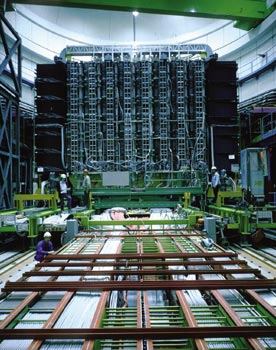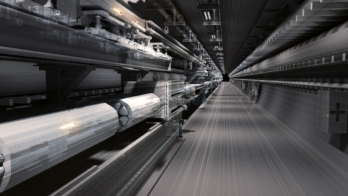In last month’s issue we traced the history of CERN-US collaboration from its post-war beginnings to the advent of proton collider physics in the 1970s. Here Gordon Fraser continues the story to the present day, which sees US researchers as one of the largest research contingents at CERN.
In the late 1970s, CERN made the bold decision to convert its new Super Proton Synchrotron (SPS), only just getting into its stride as a fixed-target machine, into a proton-antiproton collider. The fast-tracked project began operation in 1981 and soon led to CERN’s first Nobel prize. It was a new watershed for European physics.
The innovative idea to convert a major proton synchrotron in this way came from David Cline, Peter McIntyre and Carlo Rubbia, then all working in the US. It had been initially proposed to Fermilab, but the US laboratory committed itself instead to increasing the beam energy of its existing synchrotron by adding superconducting magnets. Converting the Fermilab machine into a proton-antiproton collider became a longer-term goal. With such a project scheduled in the US, there was no immediate migration to CERN’s fast-tracked version.

For the CERN collider, the lessons of the Intersecting Storage Rings (ISR) had been learned. “Keyhole” physics was not the way to go. Carlo Rubbia’s 2000 tonne UA1 experiment for the new collider completely surrounded the proton-antiproton collision point, and its sheer size was impressive by the standards of the day. From the US, it had on board a Riverside contingent (a tradition having been set at the ISR) and David Cline, then at Wisconsin. As UA1 gained momentum, more physicists came from Rubbia’s base at Harvard, from MIT, and from Wisconsin.
The CERN proton-antiproton collider was built to house more than one experiment, and there were several contenders. An unsuccessful bid was made by Sam Ting of MIT, who at that time was the leader of the Mark-J experiment at the PETRA electron-positron collider at the DESY laboratory, Hamburg. UA2, the second major experiment approved for the proton-antiproton collider, was essentially European. Additional high-energy antiproton experiments at CERN included a gas-jet target, attracting groups from Michigan and Rockefeller (including ISR pioneer Rod Cool), and a study of jet structure by a dedicated UCLA group.
For low-energy antiprotons, CERN had the LEAR ring, and several US groups contributed to experiments here. The tradition continues with the AD antiproton decelerator, notably with Gerry Gabrielse’s Harvard group making precision measurements of antiproton parameters.
The LEP era
Even while the proton-antiproton collider was getting into its stride in the early 1980s, CERN began a push for its next large machine, the 27 km LEP electron-positron collider. Such a large machine was again unique, and therefore an attraction for US physicists, who proposed the LOGIC detector. There were four slots for experiments at LEP and more than four proposals. LOGIC did not make it.

Ting, having lost out at the proton-antiproton collider, was determined to get a front seat at LEP. He, like Lederman, understood the importance of studying lepton pairs, and had got together a major international effort with scientists based in the US, China and Europe for a detector to analyse muons using a huge magnetic spectrometer. The proposal was initially labelled “L3” as it was the third letter of intent to be tabled for LEP, and the collaboration hoped that a more positive title would emerge. The experiment was approved, but no better name appeared. It went on to become a major US effort, with groups from Alabama, Boston, Caltech, Carnegie-Mellon, Harvard, Johns Hopkins, Los Alamos, Michigan, Northeastern, Oak Ridge, Princeton, Purdue and UC San Diego being introduced to research at CERN.
US researchers also collaborated in the other three LEP experiments. ALEPH, initially led by Jack Steinberger, included groups from Florida State, UC Santa Cruz, Washington/Seattle, and from Wisconsin, under Sau-Lan Wu, who had moved to LEP after previous research with the TASSO experiment at PETRA. OPAL included groups from Duke, Indiana, Maryland, Oregon and UC Riverside. DELPHI had participation from Ames, Iowa.
The SPS fixed-target programme had initially had little attraction for US physicists, as Fermilab’s machine had higher energy and was commissioned earlier. However, a new development came in the 1980s when the SPS became the scene of experiments using high-energy beams of nuclei (although the initial US push had been for an alternative heavy-ion scenario). This was a natural extension of work which had been pioneered at the Berkeley Bevalac, and the Lawrence Berkeley Laboratory made vital contributions to the ion source and nuclear beam infrastructure for these experiments.





